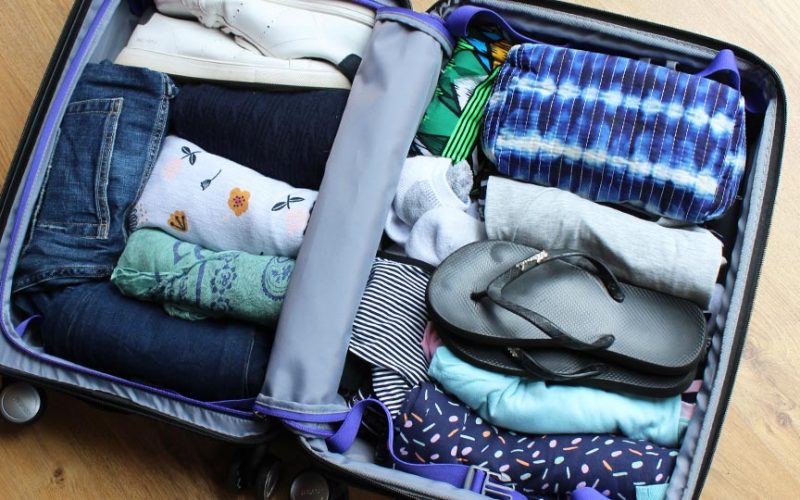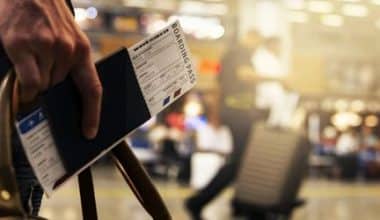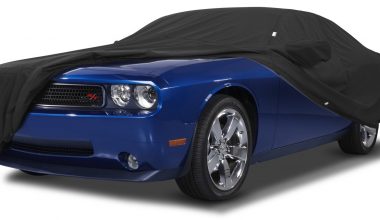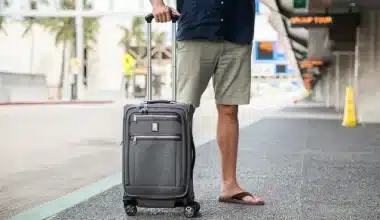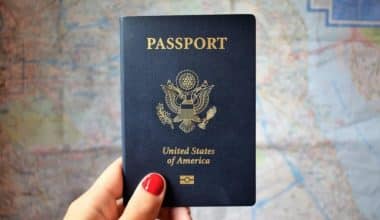We highly recommend it if you’ve never traveled with only a carry-on. Why? Well, for starters, it is liberating. There’s no need to stand in line at the airport to retrieve your checked luggage. You can quickly get through security. And you always have everything you need with you. But the question is, how do you pack a carry-on bag stress free? Don’t worry; we’ve got you covered. In this post, we’ll walk you through the best way to pack a carry-on bag step by step.
4 Reasons to Only Pack a Carry-On
At first glance, packing everything you need for a trip into a carry-on bag appears absurd. Why bother when the airline allows you to check a large suitcase with plenty of room for your belongings?
In our experience, there are four compelling reasons to bring only a carry-on:
Saving Money
Airlines will gladly allow you to bring as much luggage as you want…for a fee. And if you’re trying to save money on your flight, baggage fees can really eat into your budget.
Unless you’re flying on a low-cost carrier like EasyJet or Frontier, you won’t have to pay for your carry-on bag. So, instead of paying baggage fees, save that $25 for a tasty meal or a fun souvenir.
There is less to keep track of.
The more luggage you have, the more likely you are to forget it (or, worse, have it stolen). Plus, dragging a large suitcase around is a pain, especially if you’re in an area with cobblestone or dirt streets.
Leave that large bag at home to save yourself the trouble; your trip will be less stressful and exhausting.
No Lost Luggage
If you’ve ever spent a lot of time in an airport, you’ve probably seen the line of frantic people waiting at the airline’s customer service desk to find out where their lost luggage went. Perhaps you’ve been one of those people.
When you check a bag, you run the risk of the airline misplacing it. This can seriously derail your trip, especially if you’re far from home, jetlagged, and already stressed. If you only bring a carry-on, you won’t have to deal with this unpleasant situation.
To Save Time
Even if your luggage is not lost by the airline, it is normal to spend a half-hour or so waiting for it at the airport baggage claim.
This, in our opinion, is a huge waste of time that could be spent exploring your destination (or, if you’ve just returned from a trip, collapsing into your warm bed). When you only have a carry-on, you can step off the plane and exit the airport right away, no waiting required.
Tips to Pack the Ideal Carry-On
Persuaded to travel with only a carry-on bag? Then, consider some pointers when you decide to pack your first carry-on-only trip a success.
#1. Apply the Liquids Rule.
“What about my shampoo, conditioner, hand sanitizer, and other liquid toiletries?” is a common concern when you need to pack a carry-on.”
As long as you follow the rules, you can bring these items to your carry-on. So, what are the guidelines?
The TSA allows liquids, gels, and aerosols in containers no larger than 3.4 oz (100 ml). All of these containers must also fit into a single quart-size (1 L) bag. Most other countries have similar rules (but double-check before traveling).
The 3.4 oz or less rule applies to the majority of travel-size toiletries. If you can’t find your favorite toiletries in travel size, buy some travel bottles and fill them with shampoo, conditioner, and so on.
Finally, keep in mind that the liquids rule extends to “liquid-like foods,” such as apple sauce, peanut butter, and yogurt. So, if you intend to bring any of those in your carry-on bag, make sure they meet the size requirements.
#2. Do Not Bring Prohibited Items
While most liquids are permitted as long as they meet the size requirements, there are some items that are not permitted in a carry-on. The majority of these items are obvious, such as weapons, explosives, and items that could be used as a weapon.
Unfortunately, useful items such as Swiss Army knives and multi-tools, as well as hammers and screwdrivers, are included. However, you can purchase special multi-tools (more like keychains) that are permitted on the plane.
Consult the TSA’s list for a complete list of what you can and cannot bring in both carry-on and checked baggage.
Finally, keep in mind that, regardless of what the website says, airport security officers ultimately decide what is and isn’t allowed through security. So, if you’re unsure about something, leave it at home.
#3. Understand the airline’s size and weight restrictions.
Airlines are fairly lenient when it comes to “carry-on baggage,” but most still have size and weight restrictions. I’ve never had a problem with this, but it’s something to be aware of if you’re flying on a low-cost carrier.
The maximum size and weight for carry-on and personal items are clearly stated on the airline’s website. Normally, size is more important (I’ve never seen an airline weigh a piece of carry-on luggage). If you’re concerned about the weight of your bag, use one of these portable luggage scales to weigh it.
The best way to ensure that your carry-on will fit is to purchase a plane-specific backpack or bag.
#4. Beware of Baggage Fees on Low-Cost Airlines
Most airlines do not charge for carry-on items, but some budget airlines do. When you book your flight, they will usually make this policy very clear, but you should still check the airline’s website to be sure.
If you must pay for your carry-on, do so before you arrive at the airport. Waiting until you arrive will almost always cost you more than paying online. Paying for a carry-on is difficult enough; don’t make it any more difficult.
#5. Packing Cubes Are Your Bestie
We were skeptical when we first heard about packing cubes. Are they really worth the money and extra time spent packing them?
We can report that after using them for a few years, the answer is a resounding “Yes!” Packing cubes make fitting all of your clothes into a small bag so much easier.
Furthermore, instead of folding your clothes, we recommend rolling them. Rolling is far more efficient when packing light than folding for a department store display. Rolling your clothes + packing cubes = maximum bag space.
#6. Less is more in this case.
Certain items must be left at home when you need to pack a carry-on. Most people’s main adjustment is the amount of clothing they can bring. If you’re used to packing seven different outfits for a seven-day trip, you’ll need to alter your strategy.
Instead of packing separate outfits, pack pieces that can be combined to create multiple outfits. Check out our women’s packing guide podcast for a great example of this.
Also, keep in mind that you can re-wear items. No one will care (or notice) if you repurpose something the next day as long as it isn’t filthy or smelly. This is why we adore Bluffworks clothing: it resists stains and odors, allowing you to wear it for days on end.
Finally, if necessary, you can always do laundry. This could be done at a local laundromat, with a wash and fold service, or even in your hotel sink.
#7. Pack only what you can wear
When you need to pack a carry-on, keep the number of heavy items to a minimum. Otherwise, carrying the bag around will put undue strain on your back and arms.
Packing boots or other heavy shoes is a common blunder. While they may not be the most comfortable to wear on the plane, they are preferable to packing sandals or lightweight sneakers. Once the plane is in the air, you can always remove the boots.
Scarves, gloves, and other accessories are the same. Put them in your pockets or on your person rather than in your bag. The same goes for any jackets you’re bringing. Once in the air, you can always remove your jacket (though it would be nice to have, given the arctic temperatures aboard most planes).
#8. Choose the Right Bag
First and foremost, you’ll need a good carry-on bag.
We’ve highlighted some of our favorite carry-on bags, but this is far from an exhaustive list. There are numerous excellent carry-on bags available that will meet your requirements.
Choose between the lightweight convenience of a soft-sided bag and the added protection of a harder polycarbonate or metallic carry-on. Look for features such as a fold-out laundry bag, zippered compartments, and more.
You should keep the size in mind. Carry-on bags must be no larger than 22 inches by 14 inches by 9 inches for most major US airlines. Most carry-on bags on the market today meet that requirement, including some larger models. Remember that some European airlines have slightly smaller requirements, and larger carry-on bags may not fit in the overhead compartments of smaller regional jets in the United States.
#9. Check the Weather Conditions at Your Destination
Knowing what weather to expect can help you reduce the number of items you need to pack. Because of the sunny skies, warm weather, and extremely low chance of rain, you can leave your rain jacket and bulkier clothing at home. For cooler nights, bring one or two light sweaters or a thin jacket. If it’s going to rain most of the time, leave the warm weather clothes at home.
Packing specifically for the weather ahead allows you to cut down on items you won’t need.
#10. Pack for One Week at a Time
You’re on the road for two weeks or more, and you’re convinced you can’t fit all of your clothes into a carry-on bag. There is a workaround for this.
It’s known as laundry.
Stay at least part of your trip in an Airbnb, and make sure it has a washer and dryer. Alternatively, take advantage of your hotel’s laundry service. Even if it’s only $10 or $20, you’ll almost certainly save money on checked bag fees. Worst-case scenario: Look for a laundromat near your hotel, then find a place to eat or drink while you wait for your laundry to finish.
#11. Pack Multipurpose Clothes
Don’t get caught up in the idea that you’ll need a different outfit for each day and evening of your trip. Most of the time, you won’t need to return to your hotel to change for dinner.
Do some restaurant research ahead of time and have an idea of the types of places you’d like to eat at. If you’re going to a more upscale restaurant, bring one nicer outfit. You can always wash and wear that outfit again if you end up going to another nice restaurant.
Pack tops and bottoms that are versatile and can be worn for the majority of the activities you intend to participate in. While it may be difficult if you enjoy changing your outfits and being fashionable, rely on small accessories such as jewelry to spice up your outfits.
#12. Maintain the Freshness of Your Clothes
You don’t want to mix your dirty clothes, wet swimsuit, or muddy shoes with your clean clothes.
Use shoe bags to keep your shoes clean while also keeping dirt off your clothes.
Waterproof bags are both fashionable and functional. One is for clean socks and underwear, and the other is for dirty clothes. The extra pocket is also useful for storing a wet swimsuit.
Always keep a Tide To-Go pen or Shout wipes on hand for quick stain removal. Throw one in your suitcase if you use dryer sheets at home to keep your clothes smelling fresh.
#13. Strategically Pack
When it comes to packing, there are two schools of thought. Rolling clothes and/or using packing cubes are two of the most popular methods. I follow the rolling method, which involves rolling each individual piece of clothing rather than folding it. It saves space, reduces wrinkling, and makes your items easier to see at a glance.
Others on our team have switched to packing cubes. Packing cubes keep your clothes neatly organized and easily accessible – no more rummaging through your suitcase for the one item you need. We recommend paying a little more for nice, light, and breathable packing cubes, such as these from eBags.
#12. Wear your heaviest clothing onboard.
Wear a jacket and a sweater on the plane. Fold your jacket and place it in the overhead bin. And you might want to wear a sweater anyway to keep warm on the plane.
Wear your boots or larger shoes on the plane as well. But there’s something even more important to remember when packing shoes.
#13. Reduce the number of shoes you wear.
If there’s one way to save space, it’s to reduce the number of shoes you pack.
Do you really need those huge boots or three pairs of high heels? Stick to versatile shoes and bring only what you need. Tennis shoes are appropriate for both hiking and a night out on the town. If you need a nicer pair of shoes, limit yourself to one pair that will go with almost any outfit. If the weather and destination call for it, throw on a pair of flip-flops. Wear the bulkiest shoes possible on the plane to save space.
#14. Toiletries should be repackaged.
Stop bringing full-size shampoo and body wash bottles. They take up too much space and are unable to pass through TSA.
Instead, bring miniatures of your toiletries, such as toothpaste and deodorant. When 3oz versions of your favorite products are unavailable, use reusable bottles like GoToobs to store your shampoo, conditioner, lotion, and other products. They are made of soft silicone and will not crack like other travel-size bottles.
Pack the essential toiletries you can’t leave home without, such as that specific conditioner brand or any special creams or medications. Then, for what you’re not as picky about, rely on your accommodations.
Remember, if something doesn’t fit, you can usually buy it at your destination.
#15. Increase the Value of Your Personal Item
Finding the ideal personal item can be a game changer when it comes to sticking with a carry-on bag. Consider it a second carry-on bag, and the daunting task of packing everything you need will seem less daunting.
We love laptop backpacks with dedicated space for a laptop, tablet, electronics, and more. Even after all of that, there’s usually room for a change of clothes and a toiletry bag. But, whatever bag you choose, make sure it keeps you organized while also allowing you to pack what you need.
#16. Try out the Carry-On
This is essentially what it comes down to. All you have to do is give it a shot.
Maybe you’ve spent your entire life packed in 50-pound suitcases, whether you’re going away for a few weeks or just a few days. It has persuaded you that you require that massive bag.
However, whether you have a small backpack, a carry-on, or a massive trunk, you will fill whatever space you have. If you follow our advice, you might discover how much easier it is to travel with a carry-on.
Conclusion
We understand how intimidating it is. If you’re used to packing in large checked bags, the prospect of downsizing to a 20-inch carry-on bag appears unrealistic, if not impossible. However, with these pointers, it is possible.
How to Pack a Carry-On: Related Articles
- What to Pack for Hawaii: The Ultimate 2023 List
- How to Roll Clothes for Packing: 2023 Best Easy Guide
- What Size Is Carry-On Luggage? Best 2023 Easy TSA Guide
- What Is Web Design: Definition, Example, Software, Course & Package
